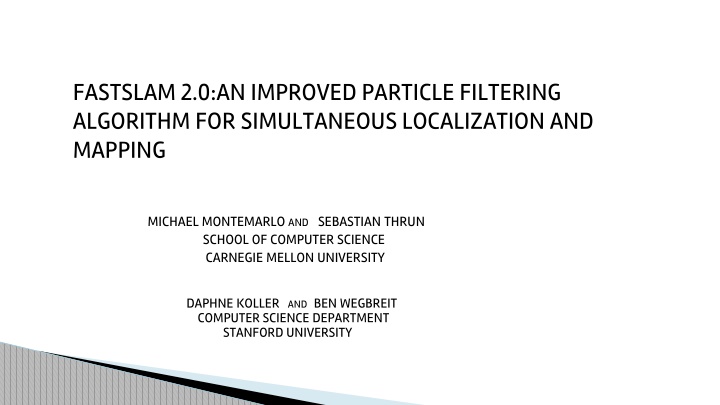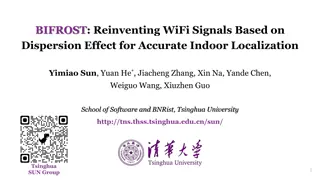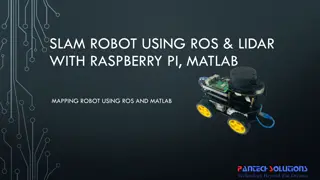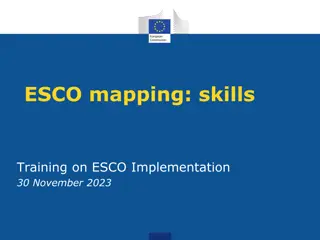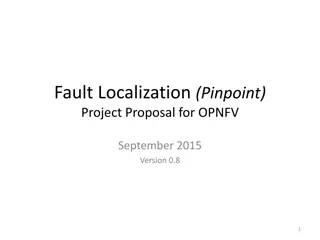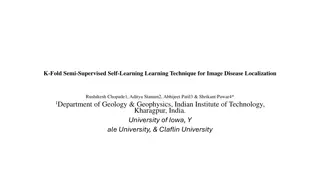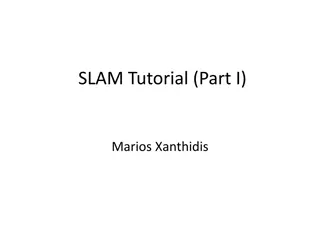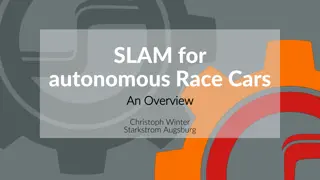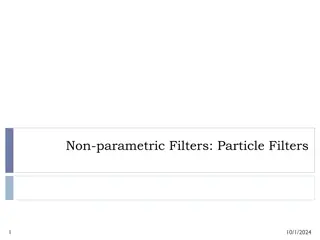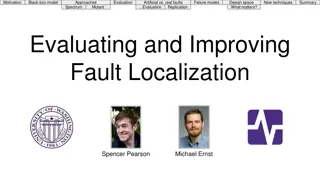FastSLAM 2.0: Particle Filtering for Localization and Mapping
This paper presents FastSLAM 2.0, an improved particle filtering algorithm for simultaneous localization and mapping, addressing deficiencies of the original algorithm. It discusses the posterior distribution, data association variables, and factorization in FastSLAM. The approach involves sampling the path with particle filters and updating poses based on motion commands. Utilizing extended Kalman filters, each particle maintains its map, enhancing accuracy in localization and mapping tasks.
Download Presentation

Please find below an Image/Link to download the presentation.
The content on the website is provided AS IS for your information and personal use only. It may not be sold, licensed, or shared on other websites without obtaining consent from the author.If you encounter any issues during the download, it is possible that the publisher has removed the file from their server.
You are allowed to download the files provided on this website for personal or commercial use, subject to the condition that they are used lawfully. All files are the property of their respective owners.
The content on the website is provided AS IS for your information and personal use only. It may not be sold, licensed, or shared on other websites without obtaining consent from the author.
E N D
Presentation Transcript
FASTSLAM 2.0:AN IMPROVED PARTICLE FILTERING ALGORITHM FOR SIMULTANEOUS LOCALIZATION AND MAPPING MICHAEL MONTEMARLO AND SEBASTIAN THRUN SCHOOL OF COMPUTER SCIENCE CARNEGIE MELLON UNIVERSITY DAPHNE KOLLER AND BEN WEGBREIT COMPUTER SCIENCE DEPARTMENT STANFORD UNIVERSITY COMPUTER SCIENCE DEPARTMENT STANFORD UNIVERSITY
Abstract This paper describes a modified version of FastSLAM, a algorithm which was originally proposed by Montemerlo et al. ,to overcomes important deficiencies of the original alogorithm. It has also been proven in the paper that the new proposed alogorithm converges for linear SLAM problems.
Related Works EKF Slam by Smith and Cheeseman Prior works by Doucet and Colleagues MCMC techniques for neural network Parallel works by van der Merwe, using unscented filtering step for generating proposal distribution.
Simultaneous localization and mapping The posterior distribution is given by: P ( , st|zt,ut,nt) Where , N landmark locations: t= 1, 2 , . , N Path of the vehicle: st= s1, s2 .. st Measurement / Observations : zt= z1, z2, . , zt Robot Control Inputs : ut= u1, u2, .. ,un Data Association variables : nt= n1,n2, .. ,nt
FastSLAM In FastSLAM the posterior can be factored as: p ( , st|zt,ut,nt)=p(st|zt,ut,nt) p ( n|st,zt,ut,nt ) n Assuming the fact that, if one knew the path of the vehicle , the landmark positions can be estimated independently to each other.
N landmark locations: mt= m1, m2 , . ,mN Path of the vehicle: xt= x1, x2 .. xt Measurement / Observations : zt= z1, z2, . , zt Robot Control Inputs : ut= u1, u2, .. ,un
The FastSLAM samples the path using a particle filter thus each particle has its own map, consisting of N extended Kalman filters.
On each update in FastSLAM begins with sampling new poses based on the recent motion command ut. S t[m] ~ p(st| s t-1[m] , ut ) target s[m] The importance Factor wt[m]= ---------------------- proposal s[m]
Importance factor Wt[m]= p( zt| n, s[m]t, nt ) p ( n | st-1,[m],zt-1,nt-1) ~ (zt ; g( n,s[m]t),Rt) ~ ( [m]n,t-1 , [m]n, t-1)
If data association is unknown ,each particle m in FastSLAM makes its own local data association decision nt by maximizing the measurement likelihood. n = argmax w[m]t(nt )
Drawbacks of FastSLAM 1.0 The inefficiency of the FastSLAM algorithm arises from its proposal distribution , which only considers the motion command but not the measurement. This approach is troublesome if the noise in the vehicle motion is large relative to the measurement noise which is typically the case in many real world robot systems.
FastSLAM 2.0 FastSLAM 2.0 implements a single new idea: poses are sampled under consideration of both the motion utand the measurement zt S t[m] ~ p(st| s t-1[m] , ut ,zt, nt )
Approximating by a linear function we get: = denotes predicted measurement, = = denotes the predicted robot pose = = denotes the predicted landmark location
Under this EKF style approximation the proposal distribution is Gaussian: Where the matrix : And the Jacobians are given by: = =
Updating the observed landmark estimate similarly to the EKF Update
Unknown Data Associations The data association for ntis computed similar to the FastSLAM :
Convergence Theorem: For Linear SLAM,FastSLAM with M=1particles converges in expectation to the correct map if all features are observed infinitely often and if the location of one feature is known in advance.
Experimental Results EKF Regular FastSLAM,M=50 particles FastSLAM 2.0,M=1 particle EKF 7807 sec 403 sec 7807 sec 140 sec The Victoria Park Dataset FastSLAM1.0 vs FastSLAM2.0
Discussion FastSLAM 2.0 algorithm utilizes a different proposal distribution , making it more efficient in situations where motion noise is higher than measurement noise. The proof of convergence is the first convergence result for a constant time SLAM algorithm. FastSLAM2.0 outperforms EKF SLAM approach by a large margin and it successfully generates an accurate map using a single particle on benchmark darta set.
